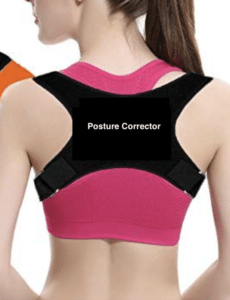Do Posture Correctors Really Work?

I have had some parents of kids who slouch, ask me if they should get their child to wear a posture corrector, so that their child can sit/stand up straighter.
There are so many different posture correctors advertised in the market. Do they work, or are they a waste of money? Most of the posture correctors work the same way. They pull the shoulders back, and prevent the upper back from hunching. Sounds good right?
Unfortunately, wearing the posture corrector for too long can result in postural muscles relying on the corrector for support, and this leads to weakened postural muscles. Postural muscles are your deep trunk, shoulder and pelvic muscles that support the spine. If you want to use a posture corrector, it should be only a temporary solution. You should only have it on for a few hours a day, and no longer than a month.
A more permanent solution to hunching would be to strengthen the postural muscles, and to work on active correction of your posture. The video below shows how you can use a resistance band (elastic exercise band) to do some strengthening exercises for your shoulder/upper back muscles.
Transcript of video:
Hello, I'm Janell Lee. I'm a pediatric physiotherapist and today I will be showing you some simple exercises you can do with the elastic band, or the Thera band to help to strengthen the muscles of your back, and of your shoulders. With strong postural muscles, this will help you to be able to maintain an optimal posture throughout the day so that you do not hunch or round your shoulders.
The first exercise I will be showing you would strengthen your rotator cuff muscles, your rotator cuff is actually a set of four muscles that helps to stabilize your shoulders When I talk about shoulder stabilization, what I mean is to bring your shoulders down and back. So you should not be doing the exercises with your shoulders lifted. When we are weak, we tend to use other stronger muscles, such as the muscles of the upper back to do the exercise. But that's not what we want, we do not want to overstrain our upper back muscles, which for many of us are already overused. We want to really strengthen the correct muscles, and that can only happen if you stabilize your shoulders, so bring your shoulders down and back.
From the side, bring your shoulders down and back. You're going to stand hip width apart, so that you are more stable. Take the theraband in your hands. Bring your elbows in towards your body. Your elbows should not be too far away from your body. So bring your elbows in, thumbs out. And then as you breathe in, you're just going to pull it out to the side. If you find this too difficult, which means the resistance is too strong, you can always just spread your hands out a little bit more so this reduces the resistance, so that it's easier when you pull it out to the sides. Let’s do it. And of course if you find it too easy, just bring your hands closer together. That will really increase the resistance. Then you can pull it, ahh.. it's too difficult for me.
Okay, so I'm just going to go back to where I'm comfortable at. Breathe in and out. I’m doing to do it from the side. Remember, keep your shoulders stabilized throughout the whole activity. Breathe in and out. When you're doing this exercise, you have to be careful that you do not do this - you should not be arching your back. So you should not be arching your back. Right, so what you want to do, is to really make sure you tuck your tummy in, as you stabilize your shoulders, and then do this exercise. Breathe in and out. So that was the exercise for the rotator cuff.
The next exercise we're going to do would strengthen your upper back and your back shoulder muscles. This would be the horizontal pull out to the sides. What you need to do, is to hold your hands just in front at shoulder height, thumbs out. Again you're standing hip width apart. Stabilize your shoulders, and then as you breathe in, you're going to pull it out to the sides, and breathe out. Just make sure that you do not lock your elbows into extension, you do not want this. Keep your elbows soft and relaxed throughout the exercise. Stabilize your shoulders. Just one more time from the front, so you can see. Breathe in and out. From the side. Breathe in and out. And again, just be careful that when you're doing this, you're not arching backwards.
The third one we are going to do, would be the triceps chest expansion. And this is a good one to try to open up your chest, especially if you tend to round your shoulders forward quite a lot throughout the day. What I'm going to do for this, I'm going to step onto the Thera band. Then, I’m going to breathe in. And as I breathe out, I'm just going to bring my hands to the back. For this, the thumbs are just pointing straight in front. Again, remember to always stabilize your shoulders. So breathe in, breathe out. From the side, this is what it looks like. Start with shoulders stabilized, thumbs pointing in front. Breathe in, breathe out and pull. Just one more time.
One last exercise is for the latissimus dorsi. I am going to need a hook where I can hook this elastic band on. So I need to readjust my camera, and I'll get back to you soon.
This is the last exercise I will be showing you, and it is the latissimus dorsi pull down. The latissimus dorsi is the broadest muscle of the back, and is on both sides and from the middle back all the way down to the lower back. So what you need to find is a hook that you can hook your elastic band over. I have a hook at the back of the door, and I’ll hook it here. I’m sorry I’m going to have to show you my back, so that I will be able to do this exercise. Basically what you do is to stand facing the elastic band, have your hands extended in front of you, stabilize your shoulders, remember to bring it down and back, and then take a breath in. And as you breathe out, you're just going to pull the band down to your sides. Just going to do it one more time. Breathe in, and out. So this is how the exercise looks like from the side. You are going to stand facing it, your arms are extended in front, elbows are not locked. My elbows are not locked and stiff, they are just relaxed. So I'm going to breathe in, breathe out. And remember to stabilize your shoulders, so bring your shoulders down and back, when you do this exercise. I'm just going to do it one more time. So, take a breath in, and breathe out.
I hope you found this four exercises simple to do, and easy to follow. If you're not sure about any part of the exercises, please feel free to reach out to me. Thank you.
**Please note that this advice is for children who slouch, hunch their backs, or have a hump on their upper backs. If your child has a curved, or twisted spine, please read up more on scoliosis.
If your child needs an assessment of his/her posture, or to learn active posture correction, or needs more core strengthening exercises, please feel free to reach out to us.
Let's get in touch
